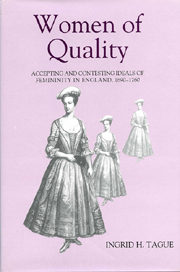Book contents
Conclusion
Published online by Cambridge University Press: 12 September 2012
Summary
Conduct writers and other early eighteenth-century social critics looked around them and were horrified by what they saw. Their society was collapsing under the weight of decadence and luxurious display, marriage and family were no longer respected, money instead of virtue dominated their contemporaries' lives. And at the heart of all these problems were women, who suddenly seemed to be leaving their houses in droves to enjoy themselves in the fashionable diversions that catered to them. Those who stayed at home were perhaps even worse, lost in the false worlds of lascivious novels written expressly for women's entertainment. In response, these commentators sought to shore up the boundaries of the gender divide. They provided women with detailed explanations of their proper social roles, and they mocked or excoriated women who chose to ignore those roles. Simultaneously, didactic writers reminded women of the satisfactions to be found at home with loving husbands – true pleasures, they argued, unlike the delusional pleasures of fashionable life.
All this, of course, sounds familiar. Complaints about rampant consumerism and the breakdown of traditional gender roles are as widespread today as they were in the eighteenth century. If today we talk about “family values” rather than “a prudent modest retired life,” much of the debate centers on similar issues. Scholars have recognized for decades that ideas about gender, and about women in particular, inform the ways in which people conceptualize their ideal societies and articulate the perceived failings of their cultures.
- Type
- Chapter
- Information
- Women of QualityAccepting and Contesting Ideals of Femininity in England, 1690–1760, pp. 218 - 223Publisher: Boydell & BrewerPrint publication year: 2002

